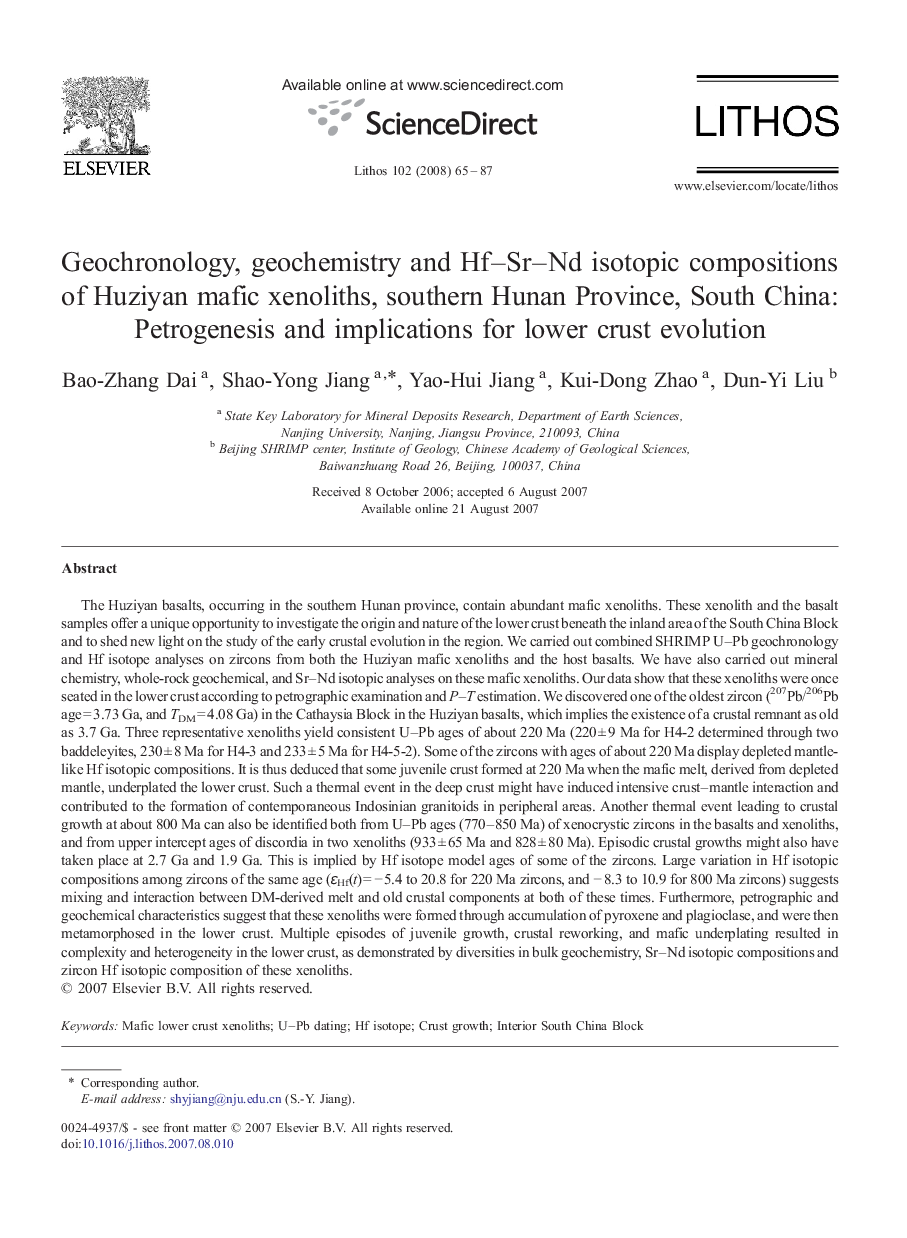| کد مقاله | کد نشریه | سال انتشار | مقاله انگلیسی | نسخه تمام متن |
|---|---|---|---|---|
| 4717511 | 1638758 | 2008 | 23 صفحه PDF | دانلود رایگان |

The Huziyan basalts, occurring in the southern Hunan province, contain abundant mafic xenoliths. These xenolith and the basalt samples offer a unique opportunity to investigate the origin and nature of the lower crust beneath the inland area of the South China Block and to shed new light on the study of the early crustal evolution in the region. We carried out combined SHRIMP U–Pb geochronology and Hf isotope analyses on zircons from both the Huziyan mafic xenoliths and the host basalts. We have also carried out mineral chemistry, whole-rock geochemical, and Sr–Nd isotopic analyses on these mafic xenoliths. Our data show that these xenoliths were once seated in the lower crust according to petrographic examination and P–T estimation. We discovered one of the oldest zircon (207Pb/206Pb age = 3.73 Ga, and TDM = 4.08 Ga) in the Cathaysia Block in the Huziyan basalts, which implies the existence of a crustal remnant as old as 3.7 Ga. Three representative xenoliths yield consistent U–Pb ages of about 220 Ma (220 ± 9 Ma for H4-2 determined through two baddeleyites, 230 ± 8 Ma for H4-3 and 233 ± 5 Ma for H4-5-2). Some of the zircons with ages of about 220 Ma display depleted mantle-like Hf isotopic compositions. It is thus deduced that some juvenile crust formed at 220 Ma when the mafic melt, derived from depleted mantle, underplated the lower crust. Such a thermal event in the deep crust might have induced intensive crust–mantle interaction and contributed to the formation of contemporaneous Indosinian granitoids in peripheral areas. Another thermal event leading to crustal growth at about 800 Ma can also be identified both from U–Pb ages (770–850 Ma) of xenocrystic zircons in the basalts and xenoliths, and from upper intercept ages of discordia in two xenoliths (933 ± 65 Ma and 828 ± 80 Ma). Episodic crustal growths might also have taken place at 2.7 Ga and 1.9 Ga. This is implied by Hf isotope model ages of some of the zircons. Large variation in Hf isotopic compositions among zircons of the same age (ɛHf(t) = − 5.4 to 20.8 for 220 Ma zircons, and − 8.3 to 10.9 for 800 Ma zircons) suggests mixing and interaction between DM-derived melt and old crustal components at both of these times. Furthermore, petrographic and geochemical characteristics suggest that these xenoliths were formed through accumulation of pyroxene and plagioclase, and were then metamorphosed in the lower crust. Multiple episodes of juvenile growth, crustal reworking, and mafic underplating resulted in complexity and heterogeneity in the lower crust, as demonstrated by diversities in bulk geochemistry, Sr–Nd isotopic compositions and zircon Hf isotopic composition of these xenoliths.
Journal: Lithos - Volume 102, Issues 1–2, April 2008, Pages 65–87